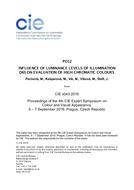Description
High chromatic colours are used largely in various industrial sectors (e.g. textiles, emergency) in last years. Aim of research was observation of influence of decreasing luminance level on assessment of respondents and verification of adaptation mechanisms in mesopic and photopic level human vision. The perception and discrimination of colour affect many aspects. These aspects are illumination, mental and physiological condition of the observer, viewing conditions, position of samples, work place and also transmission of light through of human eye, photoreceptors (rods and cones) and processing the nervous system. According different of luminance level we can talk about photopic, mesopic and scotopic vision. Change of the spectral sensitivity of the human eye at the change of luminance levels is named as the Purkinje shift. When change of luminance level is shifted the maximum luminous efficiency to the shorter wavelengths. Therefore the evaluation was carried in the viewing box with fitted a daylight simulator D65. For achieving different luminance levels are used plates. On one side of plates were applied the tint foil with light transmittance 16% or 6%. For evaluation of a group of observers were selected high chromatic colours of blue from CIELAB colour space. All samples were measured on the spectrophotometer. The samples had with distance dE=1 to dE=5 from central sample. Results of the experiment were evaluated with using formulas for evaluation of colour differences – CIELAB, CIE2000 and CIECAM02, COQ, PF/3 factor and STRESS index. From the evaluation of the observers were obtained visually perceived colour differences. The dependence visually perceived colour difference and calculated colour difference were contained the dependence visually perceived colour difference on the luminance level. Finally, the results were compared with the results of the MOVE and LRC laboratories.
Product Details
- Published:
- 09/01/2016
- Number of Pages:
- 9
- File Size:
- 1 file , 1 MB
- Product Code(s):
- x043-PO12, x043-PO12, x043-PO12
